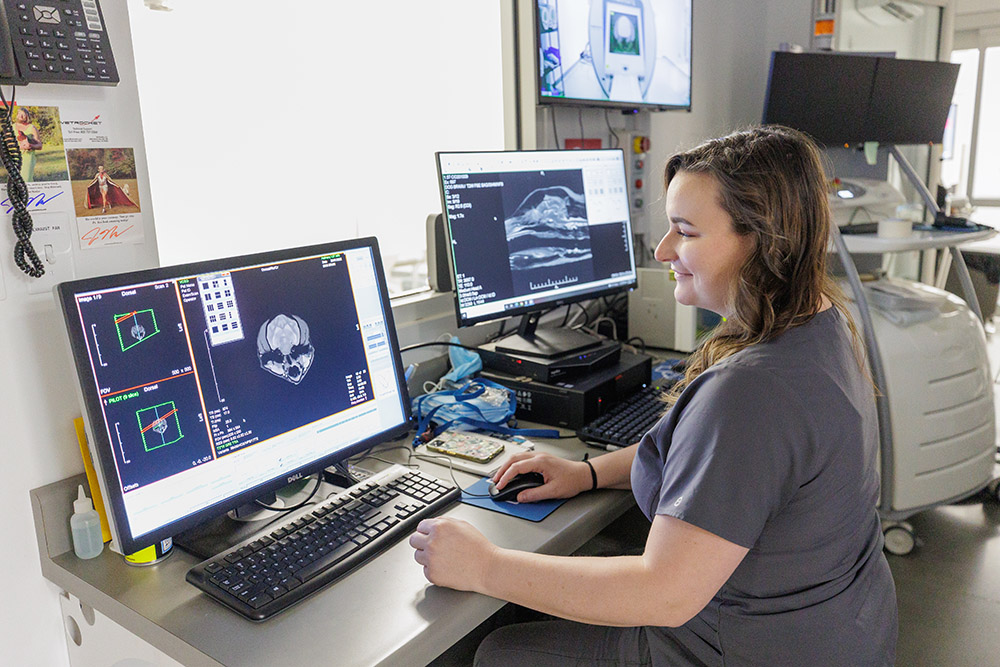Pet Diagnostics
Learn more about our pet diagnostic services below.
Pet Diagnostics In Chattanooga, TN
Pet Diagnostics
At Medical Care and Specialty Group, we use the most up-to-date technologies to provide your pet with the best possible veterinary care. When you see your pet in pain or suffering and don’t know what’s wrong, it’s difficult to know what to do. Our team at Veterinary Care and Specialty Group is well-trained in obtaining test results swiftly so that we can identify and treat your pet’s problem.
Magnetic Resonance Imaging (MRI)
An overview of the applications for small animal veterinary practice.
Spinal Disease
Imaging of spinal disease has traditionally relied upon plain radiography and almost invariably, myelography. The latter can be a time-consuming and technically demanding procedure for some specialists with some risk of post-study complications (e.g. seizures) or non-diagnostic studies (e.g. due to diffuse cord swelling). MRI allows for rapid localization and characterization of spinal lesions, with negligible risks.
Intracranial Disease
MRI is currently the best way of imaging intracranial disease, as it is not impeded by the bone of the cranial vault and it provides superior detail of soft tissue structures compared with CT scans. This makes it invaluable for the diagnosis of brain tumors.
While relatively uncommon in small animals, the incidence of CNS neoplasia has probably been under-diagnosed historically, due to lack of appropriate imaging facilities. In some cases, long-term remission can be achieved by surgical removal/debulking or radiotherapy. In addition, we have found that many clients appreciate a definitive diagnosis, and thus accurate prognosis in such cases, even if they elect not to proceed with further treatment.
Furthermore, ruling out intracranial space-occupying lesions early can help direct other diagnostic and therapeutic efforts.
Epilepsy
Primary epilepsy usually starts early in life but can occur at any age. Given that late-onset epilepsy is also treatable with anti-convulsants, it is important to rule out neoplastic/inflammatory disease in older patients. Ideally, all cases presenting with altered mentation or seizures, irrespective of age, would receive a brain scan to rule out underlying disease as part of a thorough work-up.
Nasal Disease
Radiography and endoscopy with cytology or biopsy are currently the mainstays of diagnosis in chronic nasal discharge, epistaxis, and sneezing. However, cytology has a low sensitivity for intra-nasal neoplasia; biopsies may be non-diagnostic (often due to non-representative sampling of associated inflammatory tissue); radiography is non-specific and does not delineate soft tissue masses clearly; and rhinoscopy can be hampered by lack of access to the entire nasal cavity and a field of view impeded by debris, discharge, and hemorrhage.
Historically, many cases of intranasal disease have only been diagnosed by exploratory rhinotomy – inherently an invasive procedure. MRI will evaluate the nature of abnormal soft tissue and determine the extent of the lesion, including any involvement of adjacent structures. It is therefore useful in the diagnosis of tumors, foreign bodies, and fungal disease.
Orbital Disease
MRI is highly superior to radiographic techniques. Radiographs are helpful in cases where neoplastic disease extends markedly beyond the orbit. Ultrasonography often gives both false positive and false negative diagnoses for neoplastic masses. MRI is recommended for patients in which radiography and ultrasonography fail to produce a confident diagnosis and to plan surgical procedures
Other Soft Tissues
MRI shows great promise in characterizing hepatic, splenic, renal, and pelvic lesions. The difficulty with this is the time required to achieve a scan, which can result in movement artifacts. New protocols have been revised to avoid such complications.
MRI Theory
The concept of the MRI is a chemical analysis of constituent body tissues displayed as a grey-scale in anatomical context. It uses a powerful magnetic field and radiofrequency signals to map hydrogen nuclei. The MRI machine is a powerful magnet, which aligns the protons and causes them to spin around the long axis of the magnetic field. Radiofrequency bombardment causes the nuclei to emit a signal which is related to the position and chemical environment within the tissues. The image takes several minutes to acquire, and any movement can render the image non-diagnostic, so general anesthesia is required.
Different radiofrequency pulse sequences can be used to highlight tissues in different ways. For example, T1-weighted images (T1WI) show fluid as dark, and T2-weighted images (T2WI) show fluid as bright. Fat will appear bright in both sequences. Most pathological processes will lower the fat content and raise the water content, so comparing the T1 and T2 weighted images (known as an irritation pattern) is helpful in highlighting various pathologies.
Additional sequences can be obtained by modifying T2WI to suppress the fat signal which produces a STIR sequence (Short Tau Inversion Recovery). STIR images are useful in identifying vertebral body pathology. T2WI can also be altered to suppress water-signal producing a FLAIR sequence (Fluid Attenuated Inversion Recovery). FLAIR sequences are useful for identifying pathology in or near the ventricles in CNS studies. These sequences can also be run to provide 3-D/high resolution protocols for examination of small areas of tissue in greater detail.
Another useful technique is to use contrast enhancement. Gadolinium injection identifies a breakdown in the blood/brain barrier and abnormal capillary flow which helps identify neoplasia or acute infectious processes.
Abdominal Ultrasound
Ultrasound uses a transducer that sends out ultrasound waves at a frequency too high to be heard. The ultrasound transducer is placed on the skin, and the ultrasound waves move through the body to the organs and structures within. The sound waves bounce off the organs like an echo and return to the transducer. The transducer processes the reflected waves, which are then converted by a computer into an image of the organs or tissues being examined.
The sound waves travel at different speeds depending on the type of tissue encountered – fastest through bone tissue and slowest through air. The speed at which the sound waves are returned to the transducer, as well as how much of the sound wave returns, is translated by the transducer as different types of tissue.
An ultrasound gel is placed on the transducer and the skin to allow for smooth movement of the transducer over the skin and to eliminate air between the skin and the transducer for the best sound conduction.nt in the module Design settings and even apply custom CSS to this text in the module Advanced settings.
Thoracic Ultrasound
Ultrasound uses a transducer that sends out ultrasound waves at a frequency too high to be heard. The ultrasound transducer is placed on the skin, and the ultrasound waves move through the body to the organs and structures within. The sound waves bounce off the organs like an echo and return to the transducer. The transducer processes the reflected waves, which are then converted by a computer into an image of the organs or tissues being examined.
The sound waves travel at different speeds depending on the type of tissue encountered – fastest through bone tissue and slowest through the air. The speed at which the sound waves are returned to the transducer, as well as how much of the sound wave returns, is translated by the transducer as different types of tissue.
An ultrasound gel is placed on the transducer and the skin to allow for smooth movement of the transducer over the skin and to eliminate air between the skin and the transducer for the best sound conduction.
Endoscopy
During this procedure, a veterinarian inserts an endoscope — a tubular instrument with a small camera and light at one end — into an opening of the body. Endoscopic equipment can be used to examine different internal organs.

